A Jubilee Sundial for West Somerset
The Grand Opening
-sml_sq2.jpg)
West Somerset District Council has commissioned a sundial to mark the Queen's Golden Jubilee. David Brown designed the dial and has carved the York stone which has transformed the rotunda on Minehead's seafront into an analemmatic sundial.
As well as the Jubilee logo, and a facsimile of part of the Queen's message on the 50th anniversary of her accession, the design features the emblems of West Somerset's four towns and, encircling the central quadrant, the names of all forty two parishes in this lovely District.
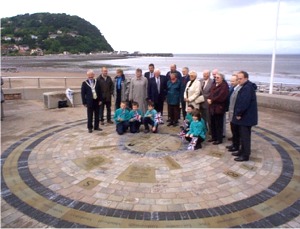
The working parts of the sundial are the North, South East and West points, the hour markers and the date scale In the centre. A carved inscription explains how you stand on the centre line so that your shadow tells the time by the hour points.
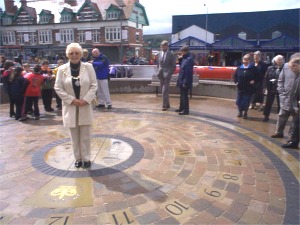
The sundial was officially opened at 11a.m on Tuesday 28 May by the Chairman of the West Somerset District Council. The Mayor of Minehead expressed her pleasure at such an attractive addition to the sea front.
Members of the District Council were in attendance and children from Townsend Road School lent a festive air to the occasion.
The commissioning, planning, carving and construction of the West Somerset Golden Jubilee Sundial has taken just three months from start to finish; showing that the West Somerset Jubilee Committee, led by chairman Steven Pugsley, is definitely in good Time on this Occasion!
Building the Sundial
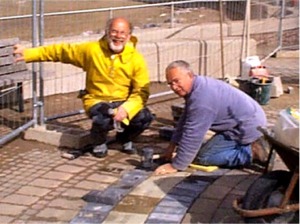
Rod Shoulders, of the West Somerset Garden Centre, helped David build the sundial. The herringbone pavers in the original central 6 metre circle of the rotunda were removed.
For the most part, Rod did the paving and David cut the stones to size where needed. And, for the most part, it rained!
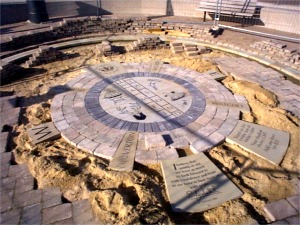
New sand was used to bed down first the central quadrant, then the outer ring of parishes then the JUBILEE panels and sundial working parts, then finally the encircling dark borders and infill circular paving.
The Design
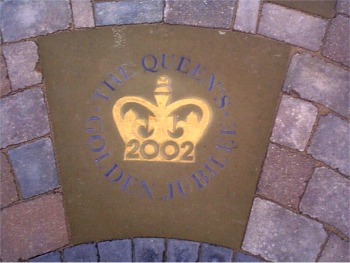
All the sundials that David makes are specially designed for particular people, places or occasions. He has been particularly pleased to create this dial for West Somerset because of his connections with the area - he lived in Minehead and Alcombe between 1965 and 1979 whilst teaching Physics at the West Somerset School.
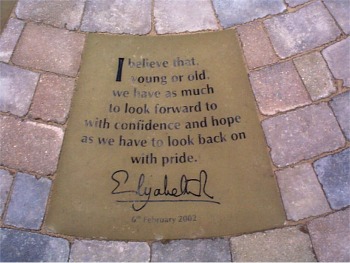
Like the jubilee panels and working parts of the sundial, the names of the parishes and the stag, ships, woolsack and hare representing Minehead, Williton, Dulverton and Watchet, are carved in hard-wearing York stone to withstand the pressure of many feet and contrast with the weathered brick paving.
The central quadrant and ring of parishes are strongly defined by three circles of dark bricks.
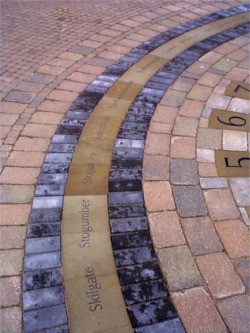
This is an analemmatic dial. David has created other dials of this type at Penshurst Place, Kent; Wisborough Green, Sussex; & Eastleigh, Hants
How it works
Sundials work when the sun causes a shadow to fall correctly on a scale of hours marked on the dial. We know that the sun appears to travel around the earth (360 degrees) once every 24 hours, so, radial lines drawn 15 ( 360/24 ) degrees apart on a surface which is parallel to the earth's equator can represent hours. This would be an equatorial dial. The shadow is cast by a rod (gnomon) rising from the centre, parallel to the earth's axis ie pointing towards the Pole Star.
Common horizontal garden sundials still have the gnomon pointing towards the Pole Star, but the hour lines are not equally spaced.
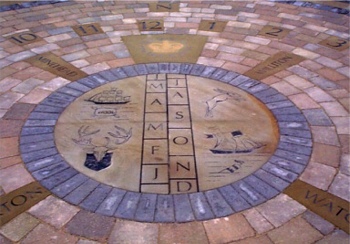
At Minehead, where the shadow is to be cast by an upright person, the hour points have to lie along an ellipse, & you also have to move on along a centre line each month through the year. This line is marked for Jan, Feb, March etc. You can just see the hour points for 10-3, and the North marker. At noon, your shadow will be cast due north. The points on the ellipse have to be correctly positioned for the latitude and longitude of the dial. So each dial is designed for its unique location.
There is also an instruction panel to the right of the south marker. This tells you where to stand, and also tells you to add one hour to the time shown during British Summer Time.
